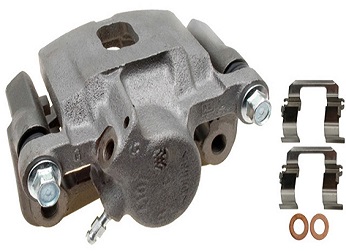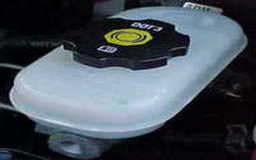
The warning signs of a disc brake caliper problem. Vehicle manufacturers put a lot of time in making their brake calipers safe for obvious reasons.
I think I can speak for all car makers when I say this is one system they don’t want customers to have a problem with. Nevertheless, it’s still possible to have problems with brake calipers.
A couple of common issues would be a binding caliper or one that develops a leak. In the first example, if you have a binding caliper, the piston doesn’t move smoothly out of its bore and winds up applying a different amount of force then the other ones on the vehicle.
When this happens the complaint from the driver is a pulling condition when applying the brakes.
In fact, with this type of caliper problem the harder the brake pedal is pushed the harder the car pulls to one side. Another symptom of a binding brake caliper is greatly accelerated pad wear.
This is a good thing, because it helps isolate the problem area. Sometimes you’ll find the inboard pad worn more than the outboard one, but overall the pads on that wheel wear at a faster rate than on the other wheels of the vehicle.
Is Brake Fluid Leaking
In the case of a caliper leaking brake fluid, most often the driver complains about an illuminated brake warning light. This can start as an intermittent condition where the light goes on and off. When fluid leaks out of the brake system there’s a float in the master cylinder that will turn on the red light. This is to notify the driver of a potentially very serious problem.

If the caliper begins leaking brake fluid the most likely cause is a failed piston seal. However, on very old vehicles the rubber brake lines can also leak out near the calipers. Some shops recommend overhauling the original calipers.
The word overhaul sounds great, but that really means they are replacing the rubber seals. A seal kit is cheap and the labor is high. This way the shop makes more money. I prefer to replace the caliper assembly with either a new or re-manufactured unit that would carry some kind of warranty.
Loaded calipers are completely assembled with new friction pads and all mounting hardware included. Besides the convenience and savings on installation time, these completely assembled calipers also reduced the odds of human error. Humans can make mistakes and I like to avoid this when talking about a caliper overhaul.
Speaking of human error, common mistakes made when replacing calipers include, over tightening the retaining bolts, forgetting to lubricate the slides and failure to bend the pad securing tabs that prevent the pad from vibrating.
Vibration can cause brake pad noise in the form of high pitched squealing. Sometimes mechanics as they rush to complete the repair will leave off anti-rattle clips, pad insulators or even worse reuse corroded caliper mounting hardware.
Corroded slides can cause a floating caliper to bind up or wear the brake pads unevenly. In the case of the loaded replacement assemblies the pads are installed the anti-rattle clips are in place, the brake pad insulators are installed and new caliper slides with bolts are installed and properly lubed. This will greatly increase the chance of quite brakes that stop as per design intent. Give this disc brake caliper page a bookmark or share with a friend.
For more information about automotive braking systems and more common problems associated with them visit my car disc brakes section.
I have also put together a page that outlines a few common problems with disc brake rotors that are also important for quiet braking. This next link takes you to the rotors page from this page about disc brake calipers.
The home page is up next and is a good place to go for a rundown of the information cover on the you fix cars website. You can also find out how to get answers to auto repair questions.

